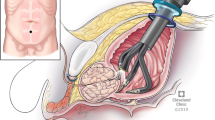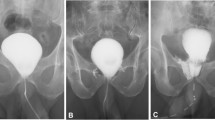Abstract
Purpose
To investigate the efficacy of continuous suturing using barbed suture for vesicourethral anastomosis (VUA) during robot-assisted laparoscopic radical prostatectomy (RARP).
Materials and methods
Seventy-three consecutive patients who underwent RARP by a single surgeon between 2020 and 2022 were retrospectively divided based on the suture type used for VUA: group A, 3–0 poliglecaprone-25 RB-1 needle (Monocryl®), n = 46; group B, 3–0 spiral polydioxanone (PDS) barbed suture with RB-1 needle (STRATAFIX®), n = 27.
Results
There was no significant difference in patient background characteristics between groups, including age, body mass index, and clinical stage. However, group B had a significantly shorter operative time, console time, hospital stay, and duration of urethral catheterization. The VUA time was significantly shorter in group B than in group A (17.9 min vs. 10.6 min; p < 0.001). Only 1 case of minor leakage was observed during the intraoperative leak test (1 patient in group A). There was no significant difference in the number of pads used at 1, 3, 6 months and 1 year postoperatively. There were no urethral strictures, and there was no significant difference in pathologic results or postoperative prostate-specific antigen progression between groups.
Conclusions
Our study suggests that the use of barbed suture during VUA for RARP is associated with reduced VUA time.
Similar content being viewed by others
Data availability
The datasets used and analyzed during the current study are available from the corresponding author on reasonable request.
Abbreviations
- LND:
-
Lymph node dissection
- RARP:
-
Robot-assisted radical prostatectomy
- VUA:
-
Vesicourethral anastomosis
References
Menon M, Tewari A, Baize B, Guillonneau B, Vallancien G (2002) Prospective comparison of radical retropubic prostatectomy and robot-assisted anatomic prostatectomy: the Vattikuti Urology Institute experience. Urology 60(5):864–868
Van Velthoven RF, Ahlering TE, Peltier A, Skarecky DW, Clayman RV (2003) Technique for laparoscopic running urethrovesical anastomosis: the single knot method. Urology 61(4):699–702
Hemal AK, Agarwal MM, Babbar P (2012) Impact of newer unidirectional and bidirectional barbed suture on vesicourethral anastomosis during robot-assisted radical prostatectomy and its comparison with polyglecaprone-25 suture: an initial experience. Int Urol Nephrol 44(1):125–132
Kaul S, Sammon J, Bhandari A, Peabody J, Rogers CG, Menon M (2010) A novel method of urethrovesical anastomosis during robot-assisted radical prostatectomy using a unidirectional barbed wound closure device: feasibility study and early outcomes in 51 patients. J Endourol 24(11):1789–1793
Sammon J, Kim TK, Trinh QD, Bhandari A, Kaul S, Sukumar S et al (2011) Anastomosis during robot-assisted radical prostatectomy: randomized controlled trial comparing barbed and standard monofilament suture. Urology 78(3):572–579
Zorn KC, Widmer H, Lattouf JB, Liberman D, Bhojani N, Trinh QD et al (2011) Novel method of knotless vesicourethral anastomosis during robot-assisted radical prostatectomy: feasibility study and early outcomes in 30 patients using the interlocked barbed unidirectional V-LOC180 suture. Can Urol Assoc J 5(3):188–194
Zorn KC, Trinh QD, Jeldres C, Schmitges J, Widmer H, Lattouf JB et al (2012) Prospective randomized trial of barbed polyglyconate suture to facilitate vesico-urethral anastomosis during robot-assisted radical prostatectomy: time reduction and cost benefit. BJU Int 109(10):1526–1532
Porreca A, Salvaggio A, Dandrea M, Cappa E, Zuccala A, Del Rosso A et al (2017) Robotic-assisted radical prostatectomy with the use of barbed sutures. Surg Technol Int 30:39–43
Cakici OU, Canda AE (2018) Bidirectional barbed only vs poliglecaprone suture with rhabdosphincter reconstruction for urethrovesical anastomosis during robotic radical prostatectomy: does it make any difference? J Endourol 32(10):944–949
Rocco B, Gregori A, Stener S, Santoro L, Bozzola A, Galli S et al (2007) Posterior reconstruction of the rhabdosphincter allows a rapid recovery of continence after transperitoneal videolaparoscopic radical prostatectomy. Eur Urol 51(4):996–1003
Rocco F, Carmignani L, Acquati P, Gadda F, Dell’Orto P, Rocco B et al (2007) Early continence recovery after open radical prostatectomy with restoration of the posterior aspect of the rhabdosphincter. Eur Urol 52(2):376–383
Massoud W, Thanigasalam R, El Hajj A, Girard F, Théveniaud PE, Chatellier G et al (2013) Does the use of a barbed polyglyconate absorbable suture have an impact on urethral anastomosis time, urethral stenosis rates, and cost effectiveness during robot-assisted radical prostatectomy? Urology 82(1):90–94
Sammon J, Perry A, Beaule L, Kinkead T, Clark D, Hansen M (2010) Robot-assisted radical prostatectomy: learning rate analysis as an objective measure of the acquisition of surgical skill. BJU Int 106(6):855–860
Li H, Liu C, Zhang H, Xu W, Liu J, Chen Y et al (2015) The use of unidirectional barbed suture for urethrovesical anastomosis during robot-assisted radical prostatectomy: a systematic review and meta-analysis of efficacy and safety. PLoS ONE 10(7):e0131167
Acknowledgements
I appreciate that English proofreading was edited by JAM Post.
Funding
None.
Author information
Authors and Affiliations
Contributions
Research conception and design: IT, KO, KW. Data acquisition: IT. Statistical analysis: IT. Drafting of the manuscript: IT. Supervision: KO, KW. Approval of the final manuscript: GT, KM, SY, SY, YK, HN, TN, KO, KW.
Corresponding author
Ethics declarations
Conflict of interest
The authors declare no conflicts of interest.
Additional information
Publisher's Note
Springer Nature remains neutral with regard to jurisdictional claims in published maps and institutional affiliations.
Rights and permissions
Springer Nature or its licensor (e.g. a society or other partner) holds exclusive rights to this article under a publishing agreement with the author(s) or other rightsholder(s); author self-archiving of the accepted manuscript version of this article is solely governed by the terms of such publishing agreement and applicable law.
About this article
Cite this article
Tsuboi, I., Ogawa, K., Tanaka, G. et al. The efficacy of STRATAFIX® spiral PDS for vesicourethral anastomosis during robot-assisted laparoscopic radical prostatectomy: a single-center retrospective study. Int Urol Nephrol 56, 137–142 (2024). https://doi.org/10.1007/s11255-023-03775-y
Received:
Accepted:
Published:
Issue Date:
DOI: https://doi.org/10.1007/s11255-023-03775-y




